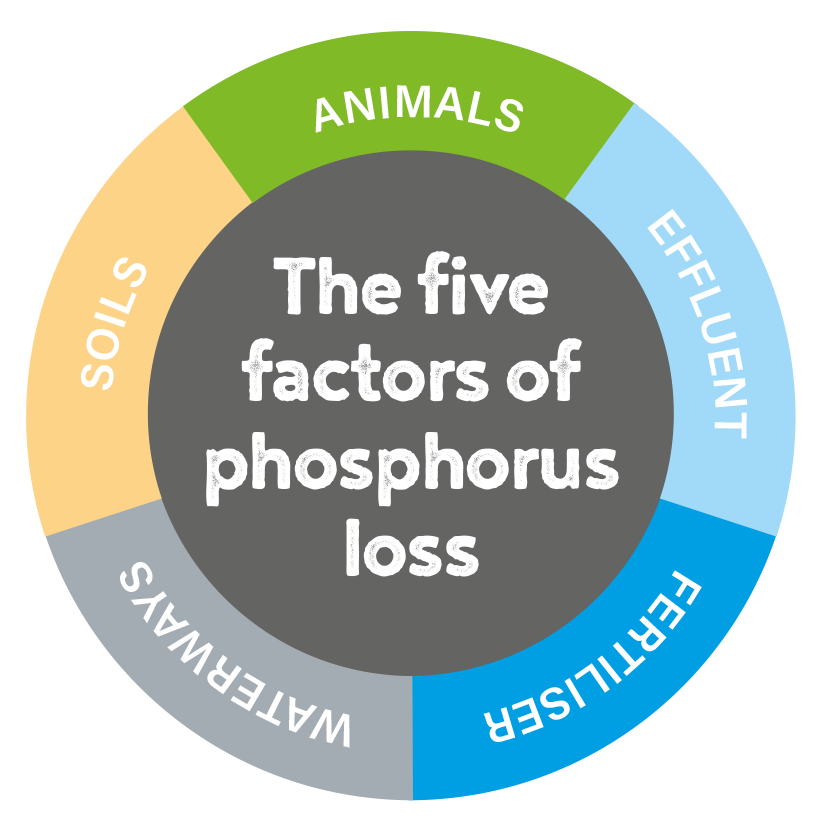Most farm systems will lose phosphorus to some degree.
There are three main mechanisms by which phosphorus can be lost to water:
- Direct application to rivers, lakes and streams
- Run-off of soluble phosphate dissolved in water
- Run-off of soil particles that have phosphate attached to them
In some soils, phosphorus may also be lost by leaching. This only occurs on soils that have very low phosphate retention characteristics, e.g. sands and podzols.
The actual amounts of phosphorus lost to waterways by run-off from pastoral land are relatively low, typically ranging from 0.1 to 2.5 kg P/ha/year. Nonetheless, they can have a significant impact on water quality, so reducing the phosphorus input into freshwater systems is important for long-term water health.
Managing phosphorus loss to water
Phosphorus from farm settings typically enters waterways mainly as particulate-associated phosphorus, i.e. attached to soil particles. Around 80% of the phosphorus lost is in this form - the rest is soluble phosphorus dissolved in run-off water. As a result, strategies that reduce soil loss to waterways will also reduce phosphorus loss.
There are five main areas where strategies to reduce phosphorus loss can be implemented. These are animals, soils, fertiliser, effluent and waterways.
Animal factors
Animals contribute to phosphorus loss in three main ways:
- By physically affecting the structure and integrity of the soil, so promoting its loss to waterways
- By depositing dung on the soil, so increasing the phosphorus levels in these areas
- By depositing dung directly into waterways
At higher stocking rates, the impact of animals is greater, and therefore the benefits of any mitigation strategies used will also be greater.
To reduce phosphorus loss, consider the following changes to stock management:
- Adopting low-impact winter grazing practices - wintering off, time-limited grazing, using a feeding pad, wintering pad or an animal shelter through winter can help to protect soils and reduce the potential loss of phosphorus
- Controlling grazing - using on-off grazing strategies on pastures reduces soil compaction and feed wastage. Grazing forage crops from the top to bottom of contours reduces soil loss
- Using good grazing practices - keeping heavy stock off steeper or vulnerable soils is especially helpful on high-risk areas. Minimising pugging also reduces the risk of run-off and phosphorus loss
Soil factors
Since such a large proportion of phosphorus loss to waterways is mediated by soil loss, maintaining soil structure and integrity and reducing erosion losses is of paramount importance.
- Identify areas that have a high potential for loss and reduce runoff from them, e.g. by using cut-offs and shaping on races and lanes. Move troughs and gateways away from water flow paths to redirect run-off into paddocks
- Reduce the amount of cultivation on farm by using techniques like direct drilling and strip cultivation. The less soil is disturbed, the lower the potential erosion
- If planting on slopes, sow along the contour, rather than up and down the hill. This will slow down run-off and reduce erosion
Fertiliser factors
Phosphate fertiliser may have direct and indirect impacts on phosphorus loss, but it is a relatively easy factor to control.
The following points should be considered:
- Use good agricultural practice - follow the fertiliser industry’s guidelines for fertiliser application in order to minimise the risk of direct loss to waterways
- Maintain soils at the agronomic optimum Olsen P for your farm. As Olsen P increases beyond the optimum, the risk of phosphorus loss also increases
- If sowing a crop, aim for precision placement of fertiliser using GPS technology or a similar approach. Phosphorus placed close to seeds is more likely to be used by the plants
- Use GPS spreading technologies to ensure fertiliser is placed on target areas, and avoids waterways and other vulnerable sites
- Avoid application when there is a high risk of heavy rainfall, which could cause run-off and phosphorus loss
- Use a low water soluble P fertiliser such as SurePhos to reduce dissolved P runoff after fertiliser application
Effluent factors
The degree of impact that effluent has on phosphorus loss depends largely on the way it is used. Loss is increased by heavy applications and by applying effluent to wet soils.
Consider the following strategies to reduce this impact:
- Increasing the effluent area - this reduces the average amount of nutrients spread per hectare
- Using low application rates if there is a risk of run-off
- Refining the application timing - aim to apply effluent when there is a small water deficit and avoid application in late autumn and winter. Adequate storage facilities are necessary to achieve this goal
- Exporting effluent - in some cases it may be possible to get someone else to use your farm effluent, e.g. on a paddock that is going to be used for maize
Waterways factors
Direct protection of streams, lakes and rivers is an effective way of reducing the amount of phosphorus that enters the water.
- Riparian planting is an effective way of filtering run-off, especially if it includes a grass margin. The impact will depend on the species used, and will be greater on slopes than on flat land
- Areas that have a steady flow of run-off to waterways during wet periods may benefit from sediment traps
- If crops are being planted alongside waterways, include a grass buffer strip to help filter run-off and reduce the risk of fertiliser loss during spreading. If effluent is being applied alongside waterways, include a grass buffer strip to reduce the risk of effluent runoff and direct effluent application to waterways occurring.
- Physically isolate waterways so that stock cannot access them. The use of fences, culverts and stock bridges which redirect runoff into paddocks not only reduces phosphorus loss to waterways, but also helps lower stock losses in waterways
Download and read the full fact sheet


Understanding phosphorus on your farm
Most New Zealand soils are naturally deficient in phosphorus (P). On farmland, high production of animal and horticultural products exacerbates deficiencies if the phosphorus removed is not replaced. Therefore, the use of phosphorusbased fertilisers is vital for the success of New Zealand agriculture.